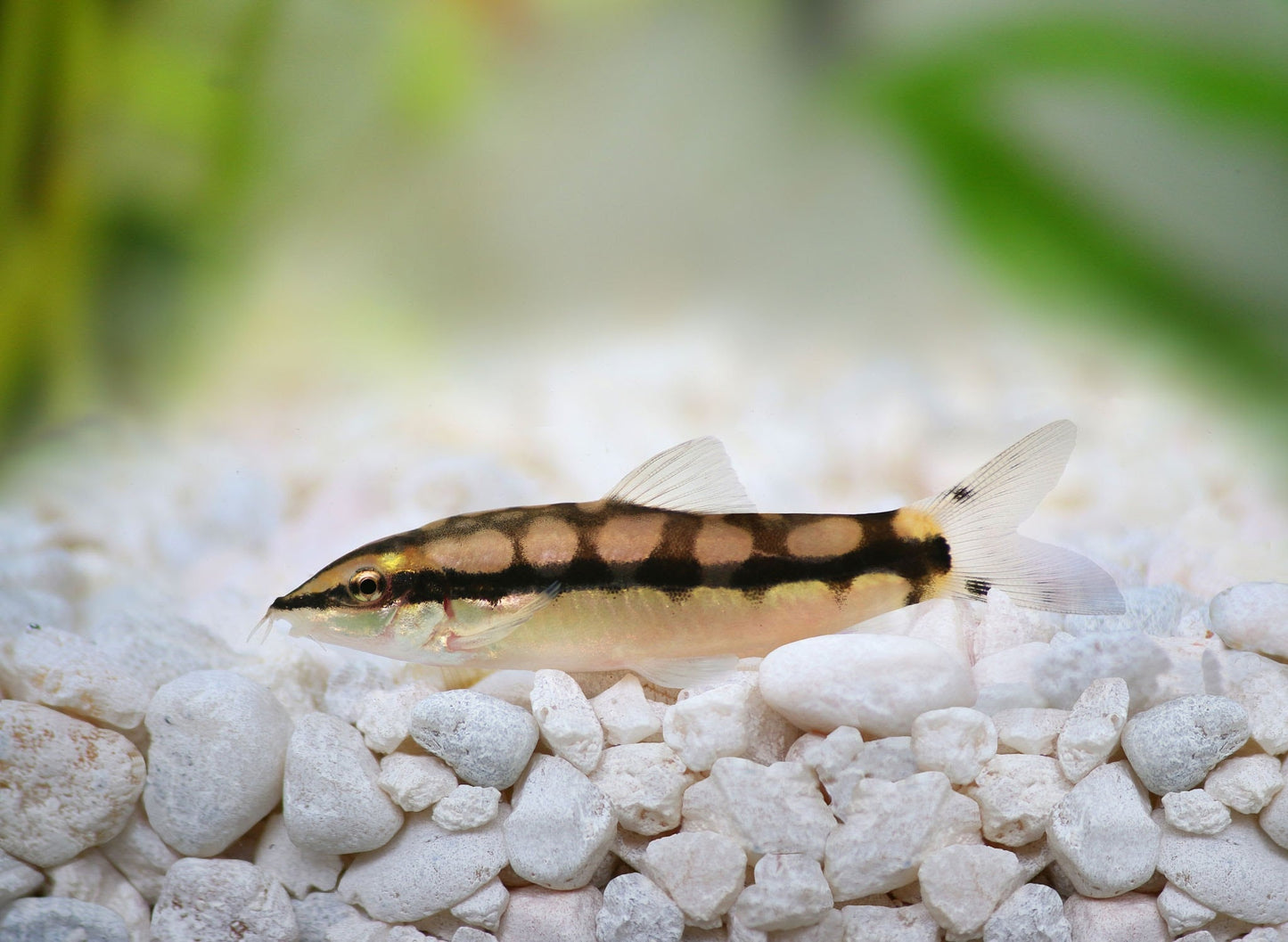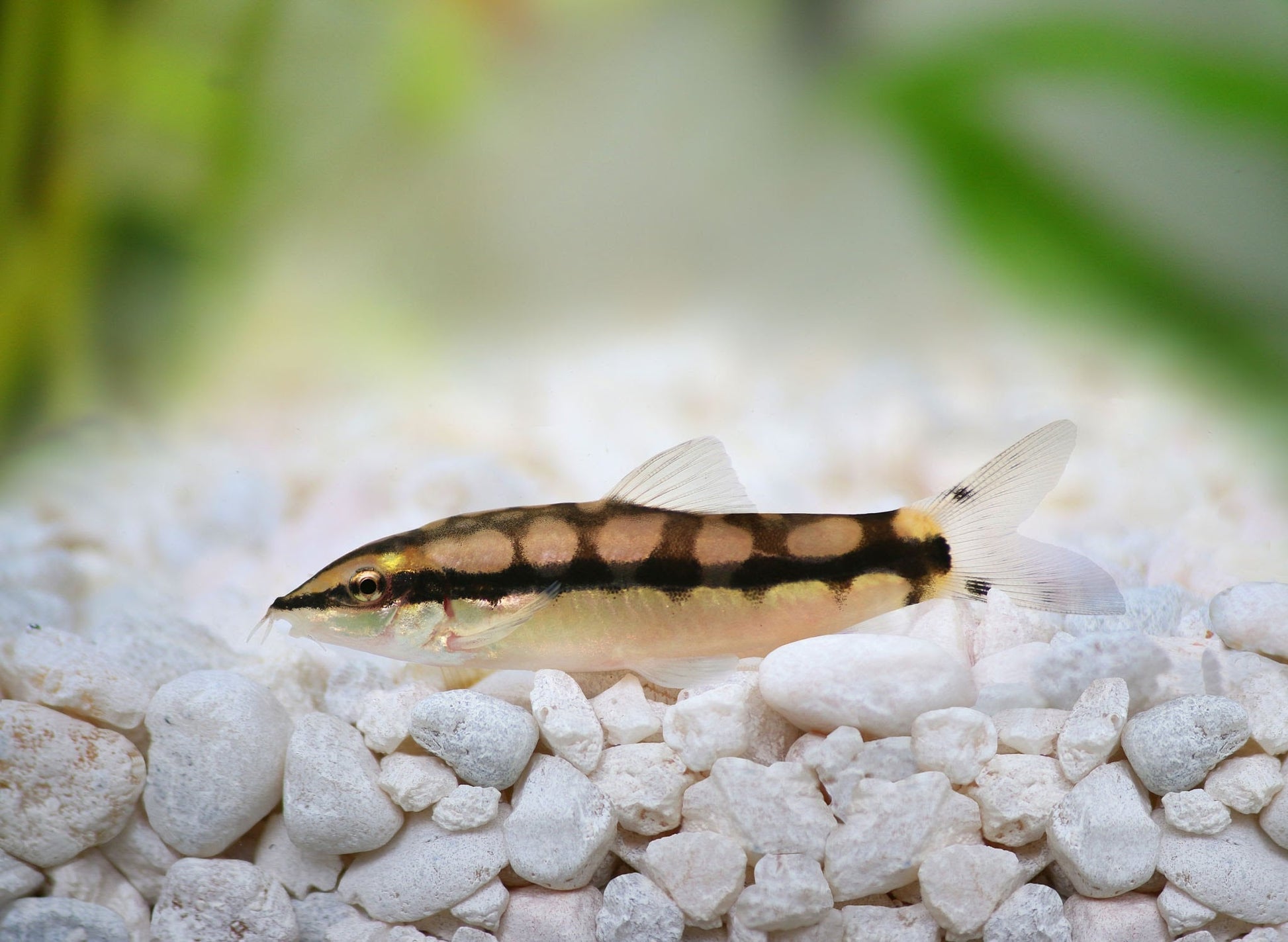Loach - Dwarf Chain (Ambastaia sidthimunki)
Loach - Dwarf Chain (Ambastaia sidthimunki)
If searching for that special something for your mature community tank, take a look at the Dwarf chain loach. With its pretty appearance, outgoing, and inquisitive personality, Yasuhikotakia sidthimunki is the smallest botiid and could be just the character to liven proceedings.
Dwarf chain loaches, or 'monkeys' or 'sids' as they are often known, once occurred in vast numbers in river basins of the Chao Phraya, Kwai and Mae Klong of Cambodia, Laos and Thailand.
Numbers are dwindling however, largely due to hydro-electric damming, and the species is declared 'critically endangered' on the IUCN red list. In Thailand it is now protected.
Thankfully, they have been spawned in captivity on a large scale, via hormone treatment, for the trade and some also naturally, but in smaller numbers, by dedicated hobbyists.
Being a dwarf species that rarely exceeds 6cm/2.4", Y. sidthimunki is a good choice for smaller aquaria. They do require room to swim though and the length and width of the tank is more important than height. I would not recommend them for any home under 76cm/30" in length.
The aquarium must be mature and have a substrate of soft sand or very fine smooth gravel to protect this fish’s delicate sensory barbels. A myriad of hiding places should be provided among bogwood, slate, rocky caves and robust planting.
Hideaways aplenty
The more refuges you create for them, the more you will see them. They need to know they always have plenty of options for a quick retreat if sensing danger. Once settled in to their surroundings, this knowledge will ensure they spend a lot of time in full view.
The water should be well oxygenated and with moderate to fast current. Many keepers of this species have noted that, when increasing the flow in the tank, their sids welcomed the change and were out playing more often.
Tight-fitting cover slides are a must as, like all loaches, they can and will jump. While delicate plants may be nipped at, species such as Anubias and Java fern (Microsorum sp.) are safe and do not seem to mind the slightly subdued lighting the loaches prefer.
Good filtration, a regular water change regime of approximately 25% per week and a varied diet will keep your sids in tip-top condition. Neutral water is best, but clean, stable conditions are more important than playing around too much with hardness and pH. Temperature should be within 24-28°C/75-82°F.
Unusually for loaches, Y. sidthimunki not only spend time on the bottom of the tank but can often be seen actively shoaling in midwater together, often playing ‘follow my leader’, stopping now and then to hover and excitedly flap their pectoral fins in enjoyment.
This behaviour means they will take food from all levels of the tank— be it flake, pellets, granules, wafers, or small meaty frozen foods.
Keep a large group all together. By this I mean a large group of sids — not a large group of mixed loach species. Not only will they then develop a complex social hierarchy within their own shoal, but their overall behaviour will be more natural.
Happy sids are those that may breed for you and, with only a handful of spawnings reported from the home aquarium, this is something to strive for.
Living in harmony?
With regards to tank mates, consider what should be a good combination. Small fish from the same continent include some of the beautiful Rasboras, such as the Harlequin (Trigonostigma heteromorpha), Narrow wedge harlequin (T. espei) and Microrasbora kubotai.
All these species seem to enjoy areas of current within the tank, and décor can be aquascaped to provide calmer areas, should they decide they’d like to move out of the stronger flow for a time.
Some small barbs and danios would co-habit well, but are much more likely to predate on eggs/fry should you be rewarded with spawning sids. Add a shoal of dither fish to the tank, as their presence will signal that all is well and the coast is clear to come out and play!
Be cautious, however, about keeping sids with slow peaceful bottom-dwelling Corydoras catfish and the like, as ‘the monkeys’ can be too boisterous.
The majority of snails however will be seen as a tasty snack, so don’t add sids to a tank of ornamental snails!
Share


